Report: Opportunities, Problems, and Strategies in Social Commerce
VerifiedAdded on 2020/03/04
|15
|3433
|138
Report
AI Summary
This report comprehensively analyzes the opportunities and challenges presented by social electronic commerce. It begins by highlighting how advancements in social media have reshaped e-commerce, creating new avenues for businesses while simultaneously introducing complexities. The report is structured into three key sections: The first section delves into the various opportunities social commerce offers, such as enhanced user engagement, increased sales, and the ability to gather valuable consumer insights. The second section examines the inherent problems, including trust issues, security concerns, and the management of brand engagement within social media platforms. The final section provides actionable strategies to mitigate these risks and maximize the benefits of social commerce. The report emphasizes the importance of understanding consumer behavior, adapting to cultural nuances, and leveraging technological advancements to thrive in the evolving landscape of social electronic commerce. This report is available on Desklib, a platform offering AI-powered study tools for students.
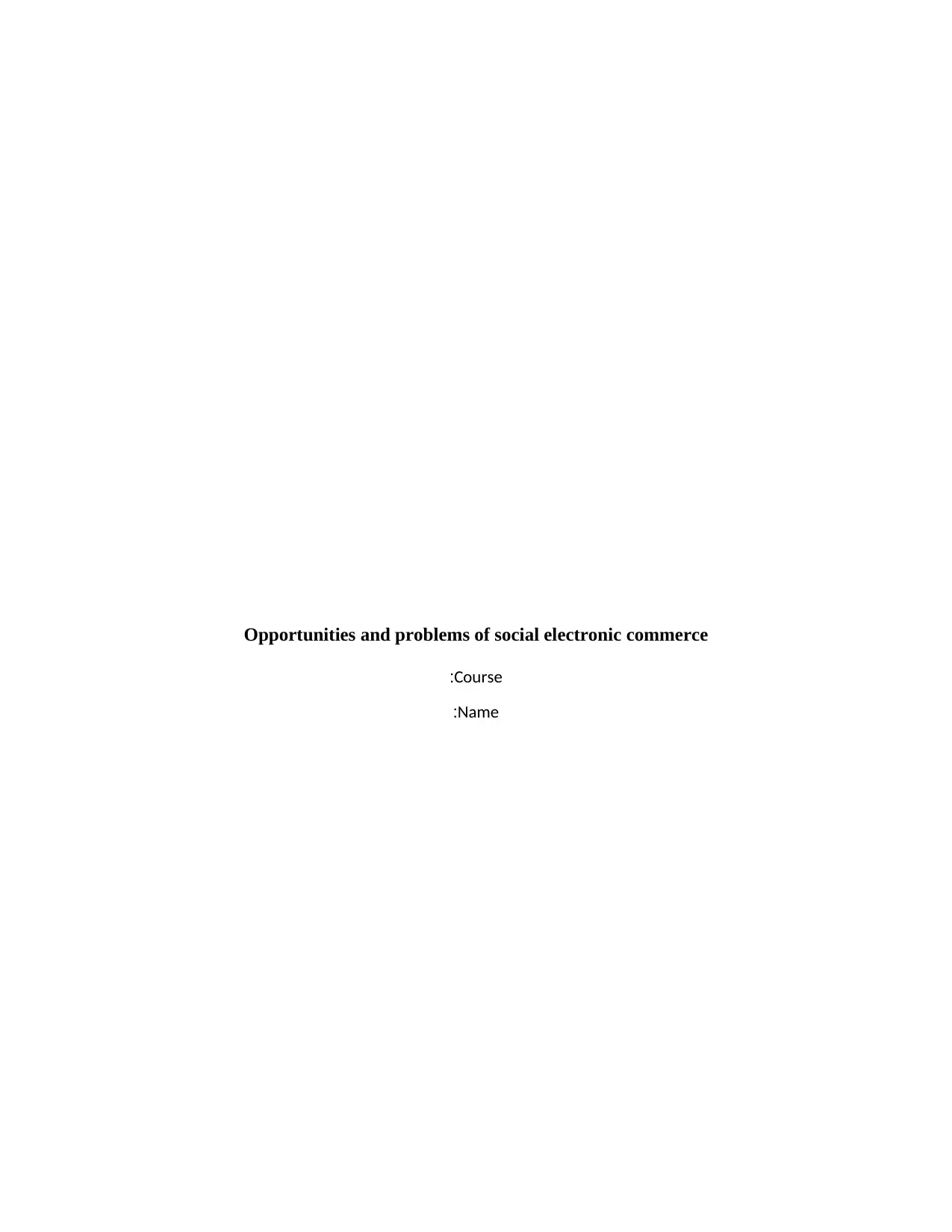
Opportunities and problems of social electronic commerce
Course:
Name:
Course:
Name:
Paraphrase This Document
Need a fresh take? Get an instant paraphrase of this document with our AI Paraphraser
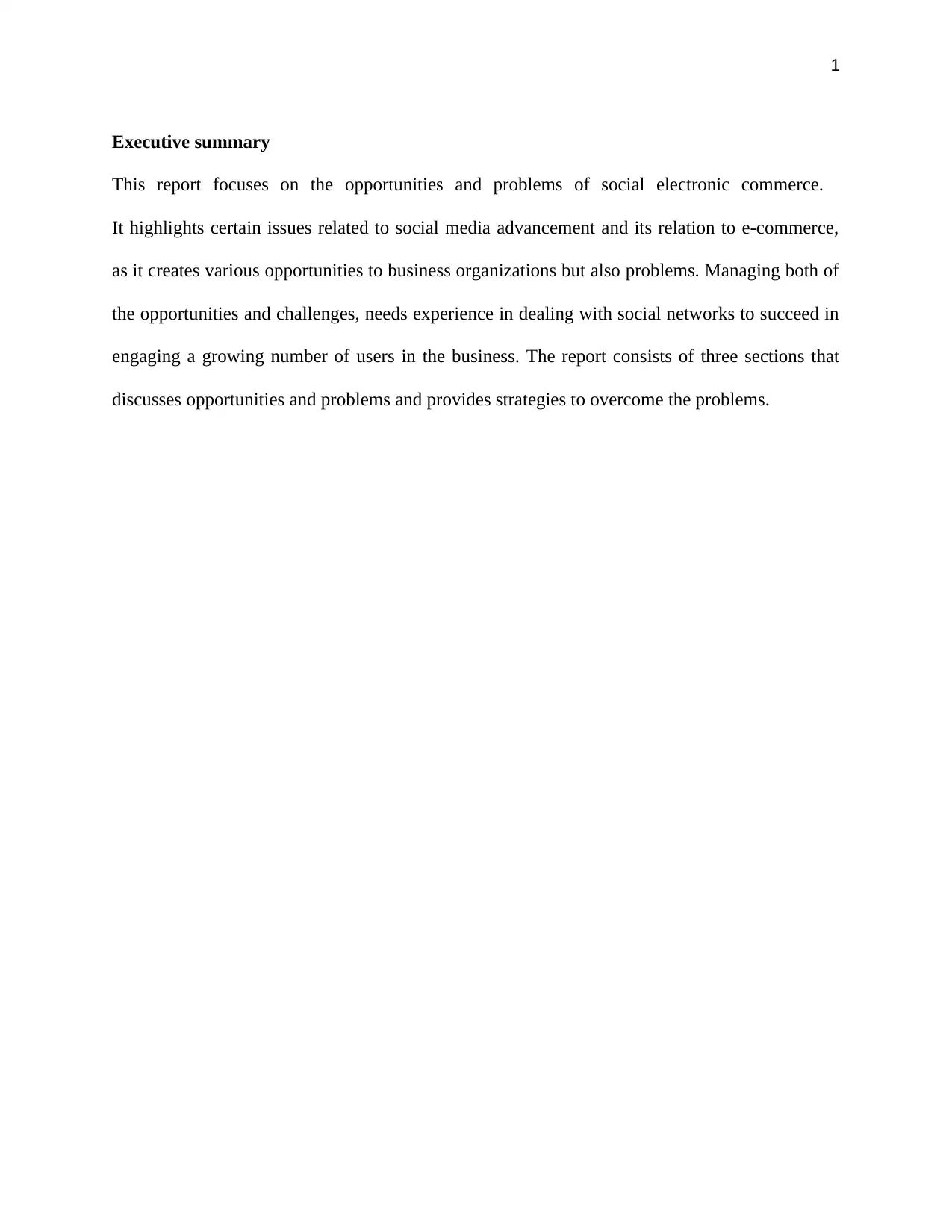
1
Executive summary
This report focuses on the opportunities and problems of social electronic commerce.
It highlights certain issues related to social media advancement and its relation to e-commerce,
as it creates various opportunities to business organizations but also problems. Managing both of
the opportunities and challenges, needs experience in dealing with social networks to succeed in
engaging a growing number of users in the business. The report consists of three sections that
discusses opportunities and problems and provides strategies to overcome the problems.
Executive summary
This report focuses on the opportunities and problems of social electronic commerce.
It highlights certain issues related to social media advancement and its relation to e-commerce,
as it creates various opportunities to business organizations but also problems. Managing both of
the opportunities and challenges, needs experience in dealing with social networks to succeed in
engaging a growing number of users in the business. The report consists of three sections that
discusses opportunities and problems and provides strategies to overcome the problems.
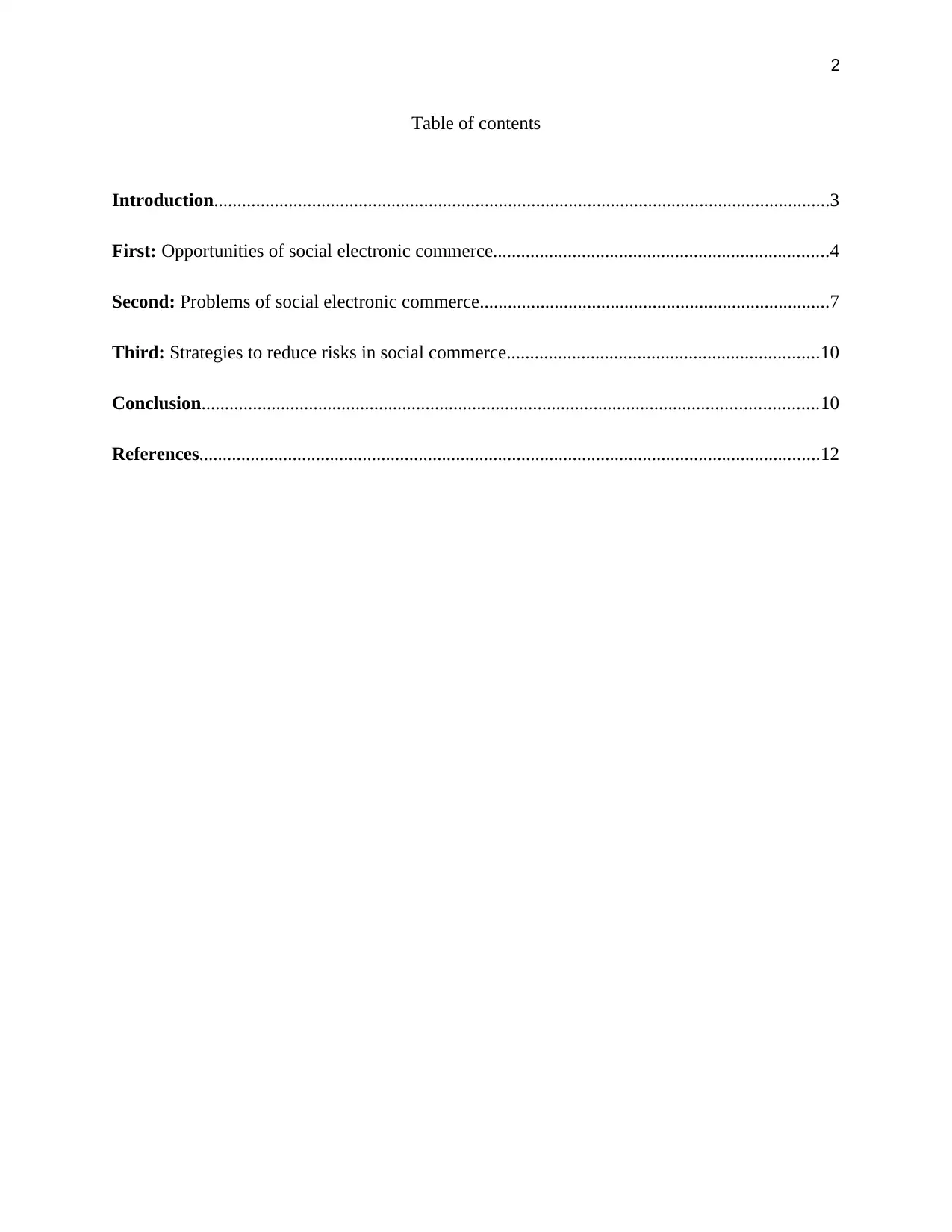
2
Table of contents
Introduction....................................................................................................................................3
First: Opportunities of social electronic commerce........................................................................4
Second: Problems of social electronic commerce...........................................................................7
Third: Strategies to reduce risks in social commerce...................................................................10
Conclusion....................................................................................................................................10
References.....................................................................................................................................12
Table of contents
Introduction....................................................................................................................................3
First: Opportunities of social electronic commerce........................................................................4
Second: Problems of social electronic commerce...........................................................................7
Third: Strategies to reduce risks in social commerce...................................................................10
Conclusion....................................................................................................................................10
References.....................................................................................................................................12
⊘ This is a preview!⊘
Do you want full access?
Subscribe today to unlock all pages.

Trusted by 1+ million students worldwide
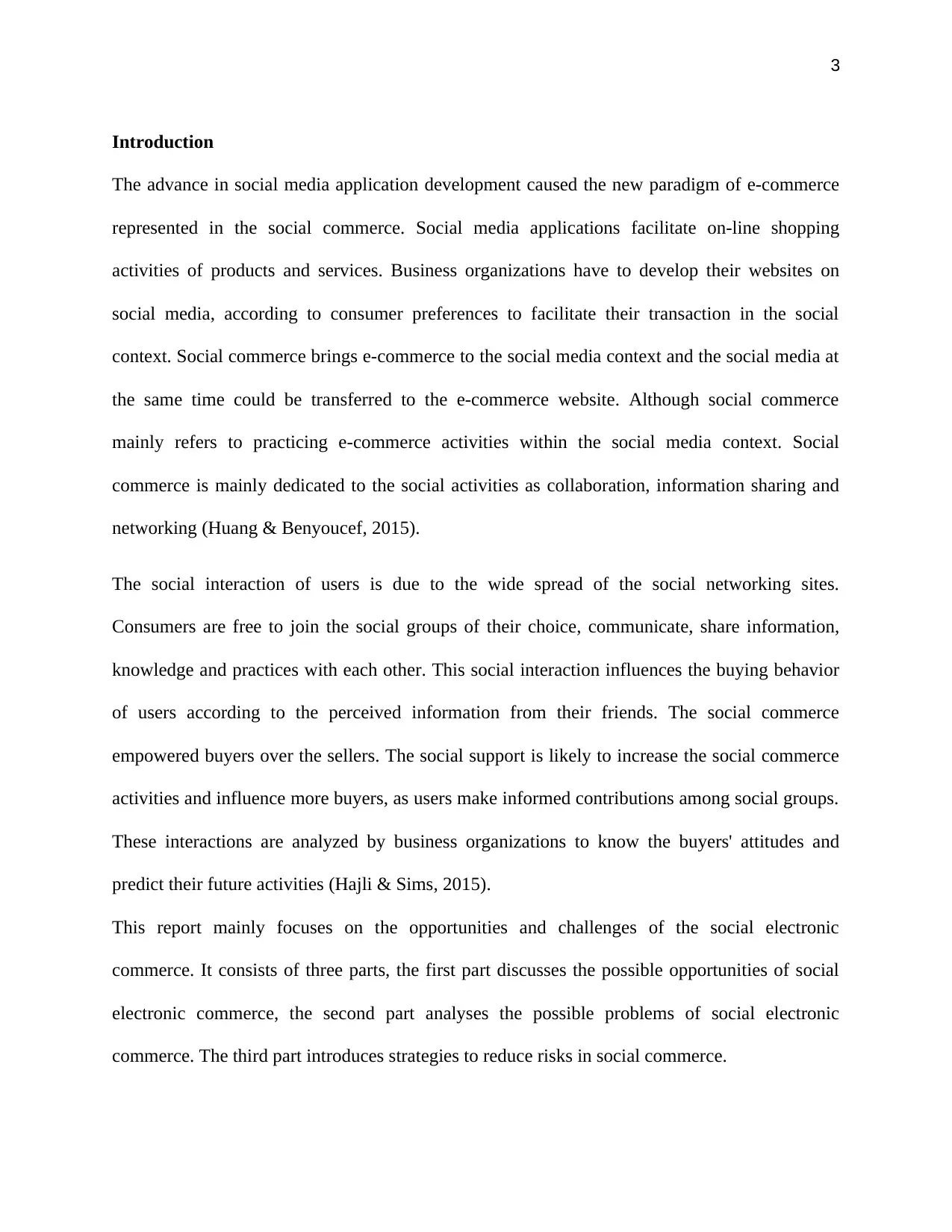
3
Introduction
The advance in social media application development caused the new paradigm of e-commerce
represented in the social commerce. Social media applications facilitate on-line shopping
activities of products and services. Business organizations have to develop their websites on
social media, according to consumer preferences to facilitate their transaction in the social
context. Social commerce brings e-commerce to the social media context and the social media at
the same time could be transferred to the e-commerce website. Although social commerce
mainly refers to practicing e-commerce activities within the social media context. Social
commerce is mainly dedicated to the social activities as collaboration, information sharing and
networking (Huang & Benyoucef, 2015).
The social interaction of users is due to the wide spread of the social networking sites.
Consumers are free to join the social groups of their choice, communicate, share information,
knowledge and practices with each other. This social interaction influences the buying behavior
of users according to the perceived information from their friends. The social commerce
empowered buyers over the sellers. The social support is likely to increase the social commerce
activities and influence more buyers, as users make informed contributions among social groups.
These interactions are analyzed by business organizations to know the buyers' attitudes and
predict their future activities (Hajli & Sims, 2015).
This report mainly focuses on the opportunities and challenges of the social electronic
commerce. It consists of three parts, the first part discusses the possible opportunities of social
electronic commerce, the second part analyses the possible problems of social electronic
commerce. The third part introduces strategies to reduce risks in social commerce.
Introduction
The advance in social media application development caused the new paradigm of e-commerce
represented in the social commerce. Social media applications facilitate on-line shopping
activities of products and services. Business organizations have to develop their websites on
social media, according to consumer preferences to facilitate their transaction in the social
context. Social commerce brings e-commerce to the social media context and the social media at
the same time could be transferred to the e-commerce website. Although social commerce
mainly refers to practicing e-commerce activities within the social media context. Social
commerce is mainly dedicated to the social activities as collaboration, information sharing and
networking (Huang & Benyoucef, 2015).
The social interaction of users is due to the wide spread of the social networking sites.
Consumers are free to join the social groups of their choice, communicate, share information,
knowledge and practices with each other. This social interaction influences the buying behavior
of users according to the perceived information from their friends. The social commerce
empowered buyers over the sellers. The social support is likely to increase the social commerce
activities and influence more buyers, as users make informed contributions among social groups.
These interactions are analyzed by business organizations to know the buyers' attitudes and
predict their future activities (Hajli & Sims, 2015).
This report mainly focuses on the opportunities and challenges of the social electronic
commerce. It consists of three parts, the first part discusses the possible opportunities of social
electronic commerce, the second part analyses the possible problems of social electronic
commerce. The third part introduces strategies to reduce risks in social commerce.
Paraphrase This Document
Need a fresh take? Get an instant paraphrase of this document with our AI Paraphraser
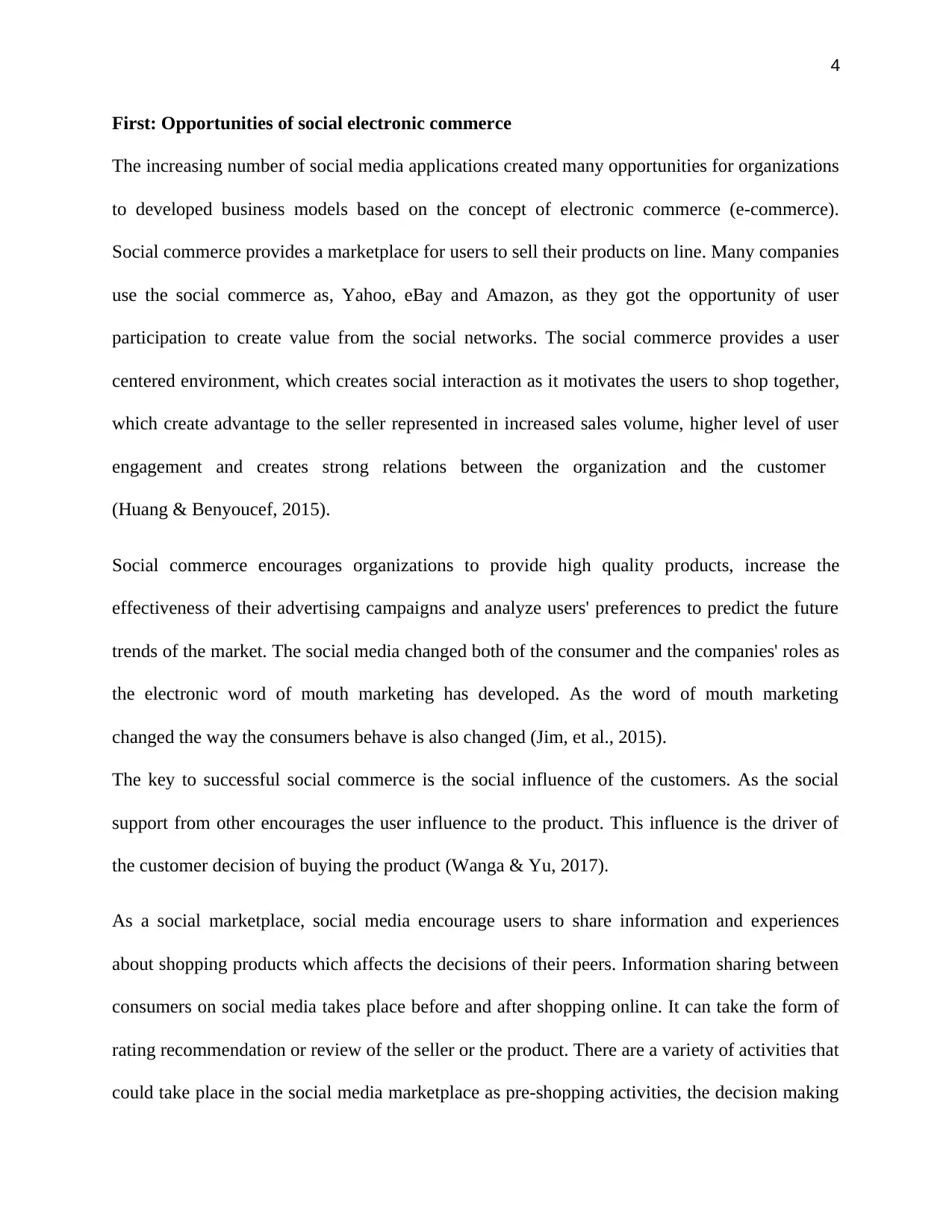
4
First: Opportunities of social electronic commerce
The increasing number of social media applications created many opportunities for organizations
to developed business models based on the concept of electronic commerce (e-commerce).
Social commerce provides a marketplace for users to sell their products on line. Many companies
use the social commerce as, Yahoo, eBay and Amazon, as they got the opportunity of user
participation to create value from the social networks. The social commerce provides a user
centered environment, which creates social interaction as it motivates the users to shop together,
which create advantage to the seller represented in increased sales volume, higher level of user
engagement and creates strong relations between the organization and the customer
(Huang & Benyoucef, 2015).
Social commerce encourages organizations to provide high quality products, increase the
effectiveness of their advertising campaigns and analyze users' preferences to predict the future
trends of the market. The social media changed both of the consumer and the companies' roles as
the electronic word of mouth marketing has developed. As the word of mouth marketing
changed the way the consumers behave is also changed (Jim, et al., 2015).
The key to successful social commerce is the social influence of the customers. As the social
support from other encourages the user influence to the product. This influence is the driver of
the customer decision of buying the product (Wanga & Yu, 2017).
As a social marketplace, social media encourage users to share information and experiences
about shopping products which affects the decisions of their peers. Information sharing between
consumers on social media takes place before and after shopping online. It can take the form of
rating recommendation or review of the seller or the product. There are a variety of activities that
could take place in the social media marketplace as pre-shopping activities, the decision making
First: Opportunities of social electronic commerce
The increasing number of social media applications created many opportunities for organizations
to developed business models based on the concept of electronic commerce (e-commerce).
Social commerce provides a marketplace for users to sell their products on line. Many companies
use the social commerce as, Yahoo, eBay and Amazon, as they got the opportunity of user
participation to create value from the social networks. The social commerce provides a user
centered environment, which creates social interaction as it motivates the users to shop together,
which create advantage to the seller represented in increased sales volume, higher level of user
engagement and creates strong relations between the organization and the customer
(Huang & Benyoucef, 2015).
Social commerce encourages organizations to provide high quality products, increase the
effectiveness of their advertising campaigns and analyze users' preferences to predict the future
trends of the market. The social media changed both of the consumer and the companies' roles as
the electronic word of mouth marketing has developed. As the word of mouth marketing
changed the way the consumers behave is also changed (Jim, et al., 2015).
The key to successful social commerce is the social influence of the customers. As the social
support from other encourages the user influence to the product. This influence is the driver of
the customer decision of buying the product (Wanga & Yu, 2017).
As a social marketplace, social media encourage users to share information and experiences
about shopping products which affects the decisions of their peers. Information sharing between
consumers on social media takes place before and after shopping online. It can take the form of
rating recommendation or review of the seller or the product. There are a variety of activities that
could take place in the social media marketplace as pre-shopping activities, the decision making
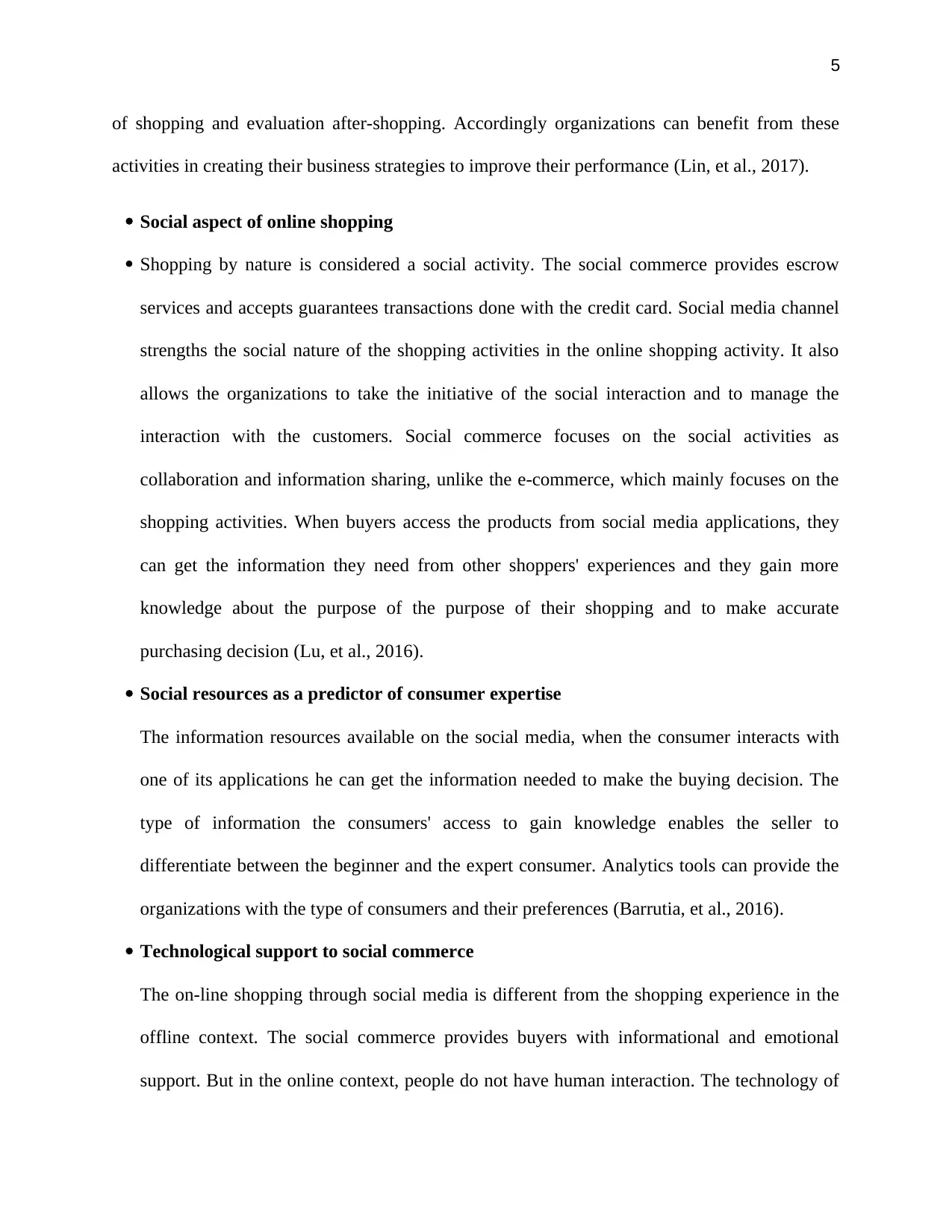
5
of shopping and evaluation after-shopping. Accordingly organizations can benefit from these
activities in creating their business strategies to improve their performance (Lin, et al., 2017).
Social aspect of online shopping
Shopping by nature is considered a social activity. The social commerce provides escrow
services and accepts guarantees transactions done with the credit card. Social media channel
strengths the social nature of the shopping activities in the online shopping activity. It also
allows the organizations to take the initiative of the social interaction and to manage the
interaction with the customers. Social commerce focuses on the social activities as
collaboration and information sharing, unlike the e-commerce, which mainly focuses on the
shopping activities. When buyers access the products from social media applications, they
can get the information they need from other shoppers' experiences and they gain more
knowledge about the purpose of the purpose of their shopping and to make accurate
purchasing decision (Lu, et al., 2016).
Social resources as a predictor of consumer expertise
The information resources available on the social media, when the consumer interacts with
one of its applications he can get the information needed to make the buying decision. The
type of information the consumers' access to gain knowledge enables the seller to
differentiate between the beginner and the expert consumer. Analytics tools can provide the
organizations with the type of consumers and their preferences (Barrutia, et al., 2016).
Technological support to social commerce
The on-line shopping through social media is different from the shopping experience in the
offline context. The social commerce provides buyers with informational and emotional
support. But in the online context, people do not have human interaction. The technology of
of shopping and evaluation after-shopping. Accordingly organizations can benefit from these
activities in creating their business strategies to improve their performance (Lin, et al., 2017).
Social aspect of online shopping
Shopping by nature is considered a social activity. The social commerce provides escrow
services and accepts guarantees transactions done with the credit card. Social media channel
strengths the social nature of the shopping activities in the online shopping activity. It also
allows the organizations to take the initiative of the social interaction and to manage the
interaction with the customers. Social commerce focuses on the social activities as
collaboration and information sharing, unlike the e-commerce, which mainly focuses on the
shopping activities. When buyers access the products from social media applications, they
can get the information they need from other shoppers' experiences and they gain more
knowledge about the purpose of the purpose of their shopping and to make accurate
purchasing decision (Lu, et al., 2016).
Social resources as a predictor of consumer expertise
The information resources available on the social media, when the consumer interacts with
one of its applications he can get the information needed to make the buying decision. The
type of information the consumers' access to gain knowledge enables the seller to
differentiate between the beginner and the expert consumer. Analytics tools can provide the
organizations with the type of consumers and their preferences (Barrutia, et al., 2016).
Technological support to social commerce
The on-line shopping through social media is different from the shopping experience in the
offline context. The social commerce provides buyers with informational and emotional
support. But in the online context, people do not have human interaction. The technology of
⊘ This is a preview!⊘
Do you want full access?
Subscribe today to unlock all pages.

Trusted by 1+ million students worldwide
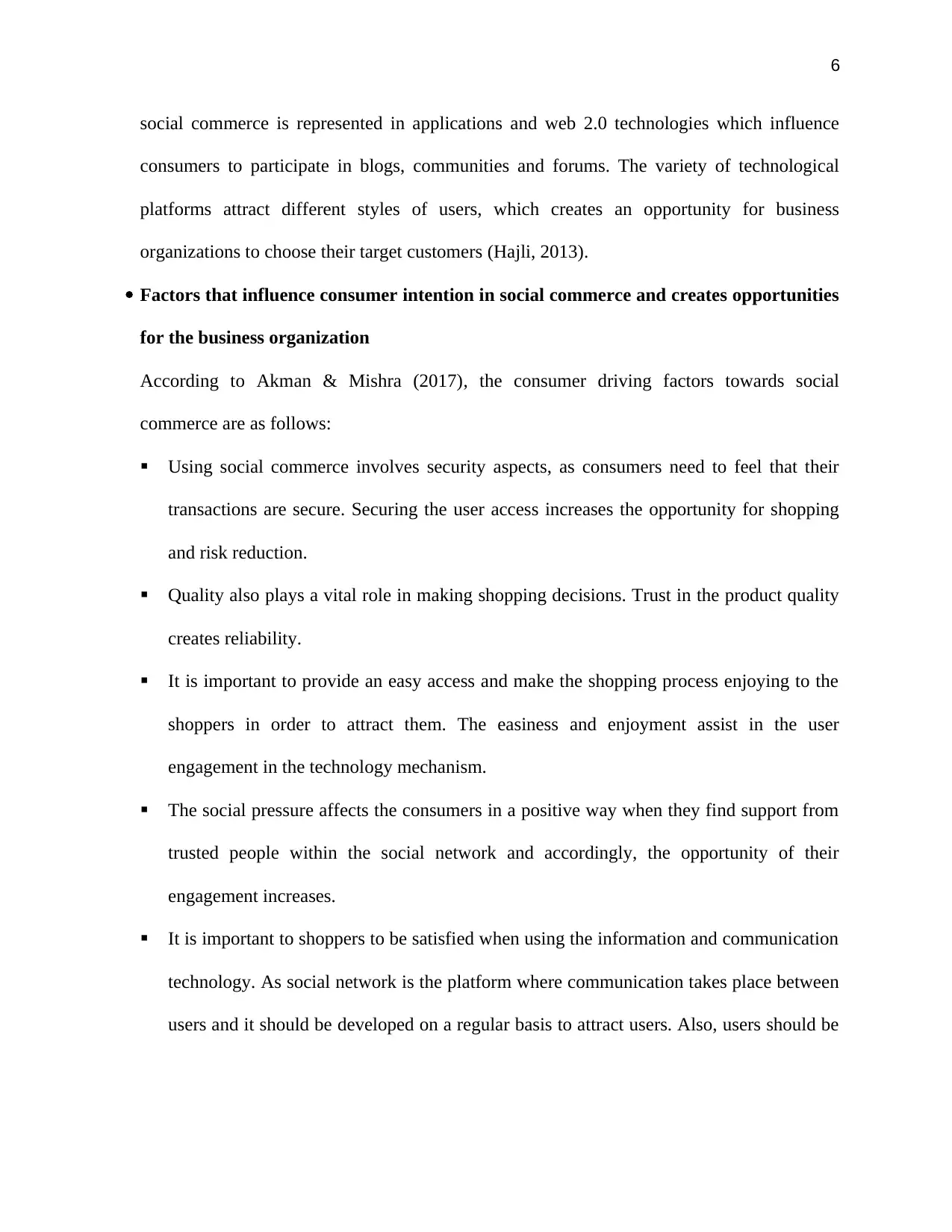
6
social commerce is represented in applications and web 2.0 technologies which influence
consumers to participate in blogs, communities and forums. The variety of technological
platforms attract different styles of users, which creates an opportunity for business
organizations to choose their target customers (Hajli, 2013).
Factors that influence consumer intention in social commerce and creates opportunities
for the business organization
According to Akman & Mishra (2017), the consumer driving factors towards social
commerce are as follows:
Using social commerce involves security aspects, as consumers need to feel that their
transactions are secure. Securing the user access increases the opportunity for shopping
and risk reduction.
Quality also plays a vital role in making shopping decisions. Trust in the product quality
creates reliability.
It is important to provide an easy access and make the shopping process enjoying to the
shoppers in order to attract them. The easiness and enjoyment assist in the user
engagement in the technology mechanism.
The social pressure affects the consumers in a positive way when they find support from
trusted people within the social network and accordingly, the opportunity of their
engagement increases.
It is important to shoppers to be satisfied when using the information and communication
technology. As social network is the platform where communication takes place between
users and it should be developed on a regular basis to attract users. Also, users should be
social commerce is represented in applications and web 2.0 technologies which influence
consumers to participate in blogs, communities and forums. The variety of technological
platforms attract different styles of users, which creates an opportunity for business
organizations to choose their target customers (Hajli, 2013).
Factors that influence consumer intention in social commerce and creates opportunities
for the business organization
According to Akman & Mishra (2017), the consumer driving factors towards social
commerce are as follows:
Using social commerce involves security aspects, as consumers need to feel that their
transactions are secure. Securing the user access increases the opportunity for shopping
and risk reduction.
Quality also plays a vital role in making shopping decisions. Trust in the product quality
creates reliability.
It is important to provide an easy access and make the shopping process enjoying to the
shoppers in order to attract them. The easiness and enjoyment assist in the user
engagement in the technology mechanism.
The social pressure affects the consumers in a positive way when they find support from
trusted people within the social network and accordingly, the opportunity of their
engagement increases.
It is important to shoppers to be satisfied when using the information and communication
technology. As social network is the platform where communication takes place between
users and it should be developed on a regular basis to attract users. Also, users should be
Paraphrase This Document
Need a fresh take? Get an instant paraphrase of this document with our AI Paraphraser
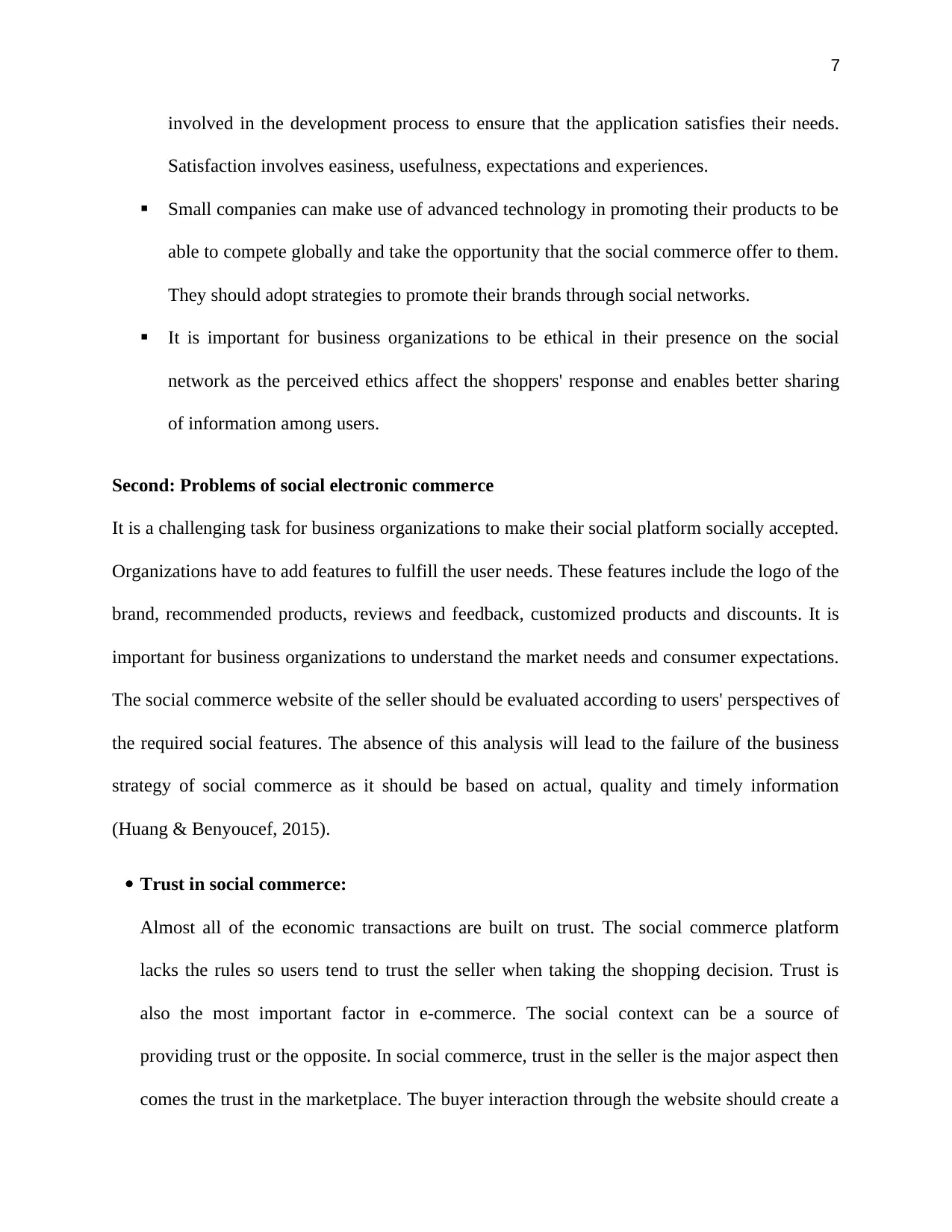
7
involved in the development process to ensure that the application satisfies their needs.
Satisfaction involves easiness, usefulness, expectations and experiences.
Small companies can make use of advanced technology in promoting their products to be
able to compete globally and take the opportunity that the social commerce offer to them.
They should adopt strategies to promote their brands through social networks.
It is important for business organizations to be ethical in their presence on the social
network as the perceived ethics affect the shoppers' response and enables better sharing
of information among users.
Second: Problems of social electronic commerce
It is a challenging task for business organizations to make their social platform socially accepted.
Organizations have to add features to fulfill the user needs. These features include the logo of the
brand, recommended products, reviews and feedback, customized products and discounts. It is
important for business organizations to understand the market needs and consumer expectations.
The social commerce website of the seller should be evaluated according to users' perspectives of
the required social features. The absence of this analysis will lead to the failure of the business
strategy of social commerce as it should be based on actual, quality and timely information
(Huang & Benyoucef, 2015).
Trust in social commerce:
Almost all of the economic transactions are built on trust. The social commerce platform
lacks the rules so users tend to trust the seller when taking the shopping decision. Trust is
also the most important factor in e-commerce. The social context can be a source of
providing trust or the opposite. In social commerce, trust in the seller is the major aspect then
comes the trust in the marketplace. The buyer interaction through the website should create a
involved in the development process to ensure that the application satisfies their needs.
Satisfaction involves easiness, usefulness, expectations and experiences.
Small companies can make use of advanced technology in promoting their products to be
able to compete globally and take the opportunity that the social commerce offer to them.
They should adopt strategies to promote their brands through social networks.
It is important for business organizations to be ethical in their presence on the social
network as the perceived ethics affect the shoppers' response and enables better sharing
of information among users.
Second: Problems of social electronic commerce
It is a challenging task for business organizations to make their social platform socially accepted.
Organizations have to add features to fulfill the user needs. These features include the logo of the
brand, recommended products, reviews and feedback, customized products and discounts. It is
important for business organizations to understand the market needs and consumer expectations.
The social commerce website of the seller should be evaluated according to users' perspectives of
the required social features. The absence of this analysis will lead to the failure of the business
strategy of social commerce as it should be based on actual, quality and timely information
(Huang & Benyoucef, 2015).
Trust in social commerce:
Almost all of the economic transactions are built on trust. The social commerce platform
lacks the rules so users tend to trust the seller when taking the shopping decision. Trust is
also the most important factor in e-commerce. The social context can be a source of
providing trust or the opposite. In social commerce, trust in the seller is the major aspect then
comes the trust in the marketplace. The buyer interaction through the website should create a
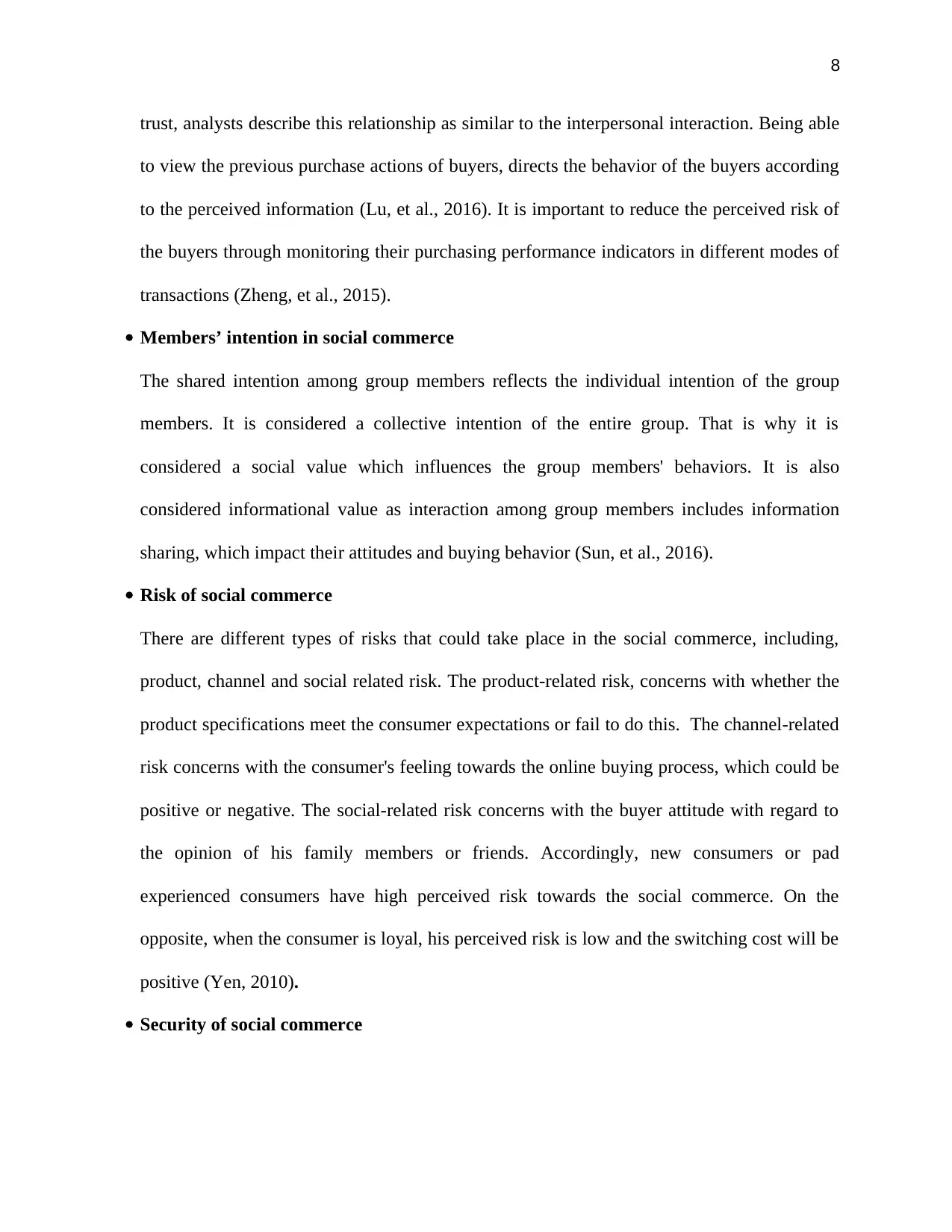
8
trust, analysts describe this relationship as similar to the interpersonal interaction. Being able
to view the previous purchase actions of buyers, directs the behavior of the buyers according
to the perceived information (Lu, et al., 2016). It is important to reduce the perceived risk of
the buyers through monitoring their purchasing performance indicators in different modes of
transactions (Zheng, et al., 2015).
Members’ intention in social commerce
The shared intention among group members reflects the individual intention of the group
members. It is considered a collective intention of the entire group. That is why it is
considered a social value which influences the group members' behaviors. It is also
considered informational value as interaction among group members includes information
sharing, which impact their attitudes and buying behavior (Sun, et al., 2016).
Risk of social commerce
There are different types of risks that could take place in the social commerce, including,
product, channel and social related risk. The product-related risk, concerns with whether the
product specifications meet the consumer expectations or fail to do this. The channel-related
risk concerns with the consumer's feeling towards the online buying process, which could be
positive or negative. The social-related risk concerns with the buyer attitude with regard to
the opinion of his family members or friends. Accordingly, new consumers or pad
experienced consumers have high perceived risk towards the social commerce. On the
opposite, when the consumer is loyal, his perceived risk is low and the switching cost will be
positive (Yen, 2010).
Security of social commerce
trust, analysts describe this relationship as similar to the interpersonal interaction. Being able
to view the previous purchase actions of buyers, directs the behavior of the buyers according
to the perceived information (Lu, et al., 2016). It is important to reduce the perceived risk of
the buyers through monitoring their purchasing performance indicators in different modes of
transactions (Zheng, et al., 2015).
Members’ intention in social commerce
The shared intention among group members reflects the individual intention of the group
members. It is considered a collective intention of the entire group. That is why it is
considered a social value which influences the group members' behaviors. It is also
considered informational value as interaction among group members includes information
sharing, which impact their attitudes and buying behavior (Sun, et al., 2016).
Risk of social commerce
There are different types of risks that could take place in the social commerce, including,
product, channel and social related risk. The product-related risk, concerns with whether the
product specifications meet the consumer expectations or fail to do this. The channel-related
risk concerns with the consumer's feeling towards the online buying process, which could be
positive or negative. The social-related risk concerns with the buyer attitude with regard to
the opinion of his family members or friends. Accordingly, new consumers or pad
experienced consumers have high perceived risk towards the social commerce. On the
opposite, when the consumer is loyal, his perceived risk is low and the switching cost will be
positive (Yen, 2010).
Security of social commerce
⊘ This is a preview!⊘
Do you want full access?
Subscribe today to unlock all pages.

Trusted by 1+ million students worldwide
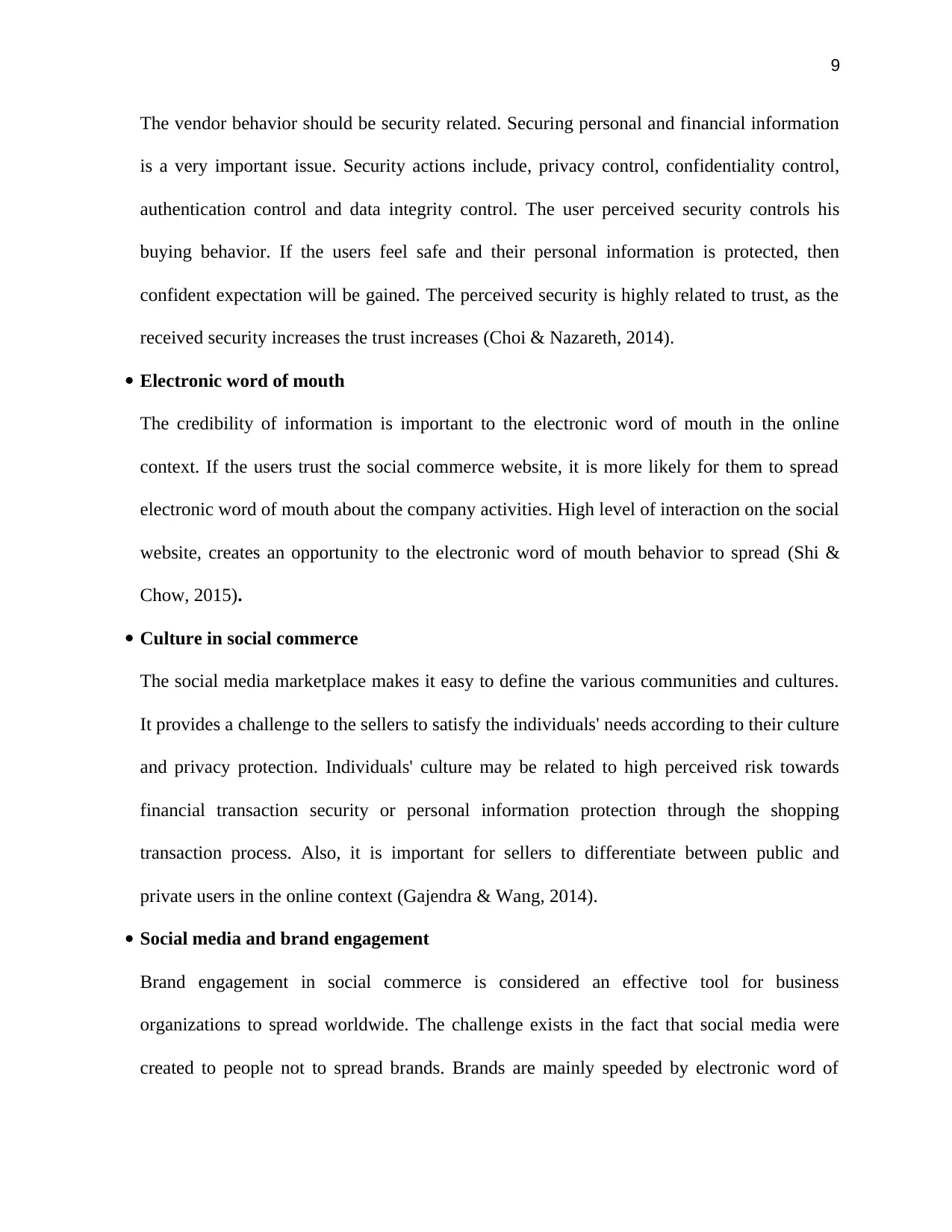
9
The vendor behavior should be security related. Securing personal and financial information
is a very important issue. Security actions include, privacy control, confidentiality control,
authentication control and data integrity control. The user perceived security controls his
buying behavior. If the users feel safe and their personal information is protected, then
confident expectation will be gained. The perceived security is highly related to trust, as the
received security increases the trust increases (Choi & Nazareth, 2014).
Electronic word of mouth
The credibility of information is important to the electronic word of mouth in the online
context. If the users trust the social commerce website, it is more likely for them to spread
electronic word of mouth about the company activities. High level of interaction on the social
website, creates an opportunity to the electronic word of mouth behavior to spread (Shi &
Chow, 2015).
Culture in social commerce
The social media marketplace makes it easy to define the various communities and cultures.
It provides a challenge to the sellers to satisfy the individuals' needs according to their culture
and privacy protection. Individuals' culture may be related to high perceived risk towards
financial transaction security or personal information protection through the shopping
transaction process. Also, it is important for sellers to differentiate between public and
private users in the online context (Gajendra & Wang, 2014).
Social media and brand engagement
Brand engagement in social commerce is considered an effective tool for business
organizations to spread worldwide. The challenge exists in the fact that social media were
created to people not to spread brands. Brands are mainly speeded by electronic word of
The vendor behavior should be security related. Securing personal and financial information
is a very important issue. Security actions include, privacy control, confidentiality control,
authentication control and data integrity control. The user perceived security controls his
buying behavior. If the users feel safe and their personal information is protected, then
confident expectation will be gained. The perceived security is highly related to trust, as the
received security increases the trust increases (Choi & Nazareth, 2014).
Electronic word of mouth
The credibility of information is important to the electronic word of mouth in the online
context. If the users trust the social commerce website, it is more likely for them to spread
electronic word of mouth about the company activities. High level of interaction on the social
website, creates an opportunity to the electronic word of mouth behavior to spread (Shi &
Chow, 2015).
Culture in social commerce
The social media marketplace makes it easy to define the various communities and cultures.
It provides a challenge to the sellers to satisfy the individuals' needs according to their culture
and privacy protection. Individuals' culture may be related to high perceived risk towards
financial transaction security or personal information protection through the shopping
transaction process. Also, it is important for sellers to differentiate between public and
private users in the online context (Gajendra & Wang, 2014).
Social media and brand engagement
Brand engagement in social commerce is considered an effective tool for business
organizations to spread worldwide. The challenge exists in the fact that social media were
created to people not to spread brands. Brands are mainly speeded by electronic word of
Paraphrase This Document
Need a fresh take? Get an instant paraphrase of this document with our AI Paraphraser
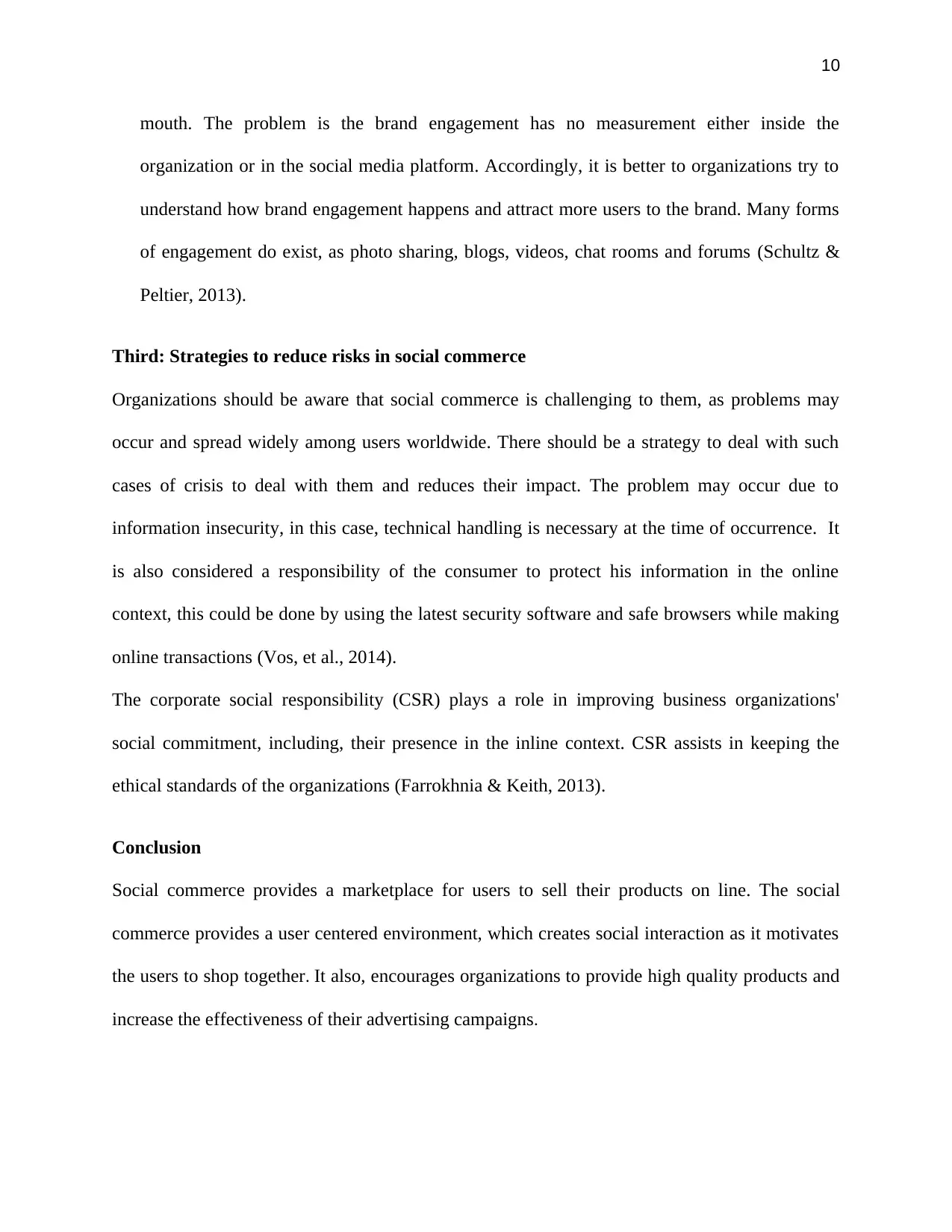
10
mouth. The problem is the brand engagement has no measurement either inside the
organization or in the social media platform. Accordingly, it is better to organizations try to
understand how brand engagement happens and attract more users to the brand. Many forms
of engagement do exist, as photo sharing, blogs, videos, chat rooms and forums (Schultz &
Peltier, 2013).
Third: Strategies to reduce risks in social commerce
Organizations should be aware that social commerce is challenging to them, as problems may
occur and spread widely among users worldwide. There should be a strategy to deal with such
cases of crisis to deal with them and reduces their impact. The problem may occur due to
information insecurity, in this case, technical handling is necessary at the time of occurrence. It
is also considered a responsibility of the consumer to protect his information in the online
context, this could be done by using the latest security software and safe browsers while making
online transactions (Vos, et al., 2014).
The corporate social responsibility (CSR) plays a role in improving business organizations'
social commitment, including, their presence in the inline context. CSR assists in keeping the
ethical standards of the organizations (Farrokhnia & Keith, 2013).
Conclusion
Social commerce provides a marketplace for users to sell their products on line. The social
commerce provides a user centered environment, which creates social interaction as it motivates
the users to shop together. It also, encourages organizations to provide high quality products and
increase the effectiveness of their advertising campaigns.
mouth. The problem is the brand engagement has no measurement either inside the
organization or in the social media platform. Accordingly, it is better to organizations try to
understand how brand engagement happens and attract more users to the brand. Many forms
of engagement do exist, as photo sharing, blogs, videos, chat rooms and forums (Schultz &
Peltier, 2013).
Third: Strategies to reduce risks in social commerce
Organizations should be aware that social commerce is challenging to them, as problems may
occur and spread widely among users worldwide. There should be a strategy to deal with such
cases of crisis to deal with them and reduces their impact. The problem may occur due to
information insecurity, in this case, technical handling is necessary at the time of occurrence. It
is also considered a responsibility of the consumer to protect his information in the online
context, this could be done by using the latest security software and safe browsers while making
online transactions (Vos, et al., 2014).
The corporate social responsibility (CSR) plays a role in improving business organizations'
social commitment, including, their presence in the inline context. CSR assists in keeping the
ethical standards of the organizations (Farrokhnia & Keith, 2013).
Conclusion
Social commerce provides a marketplace for users to sell their products on line. The social
commerce provides a user centered environment, which creates social interaction as it motivates
the users to shop together. It also, encourages organizations to provide high quality products and
increase the effectiveness of their advertising campaigns.
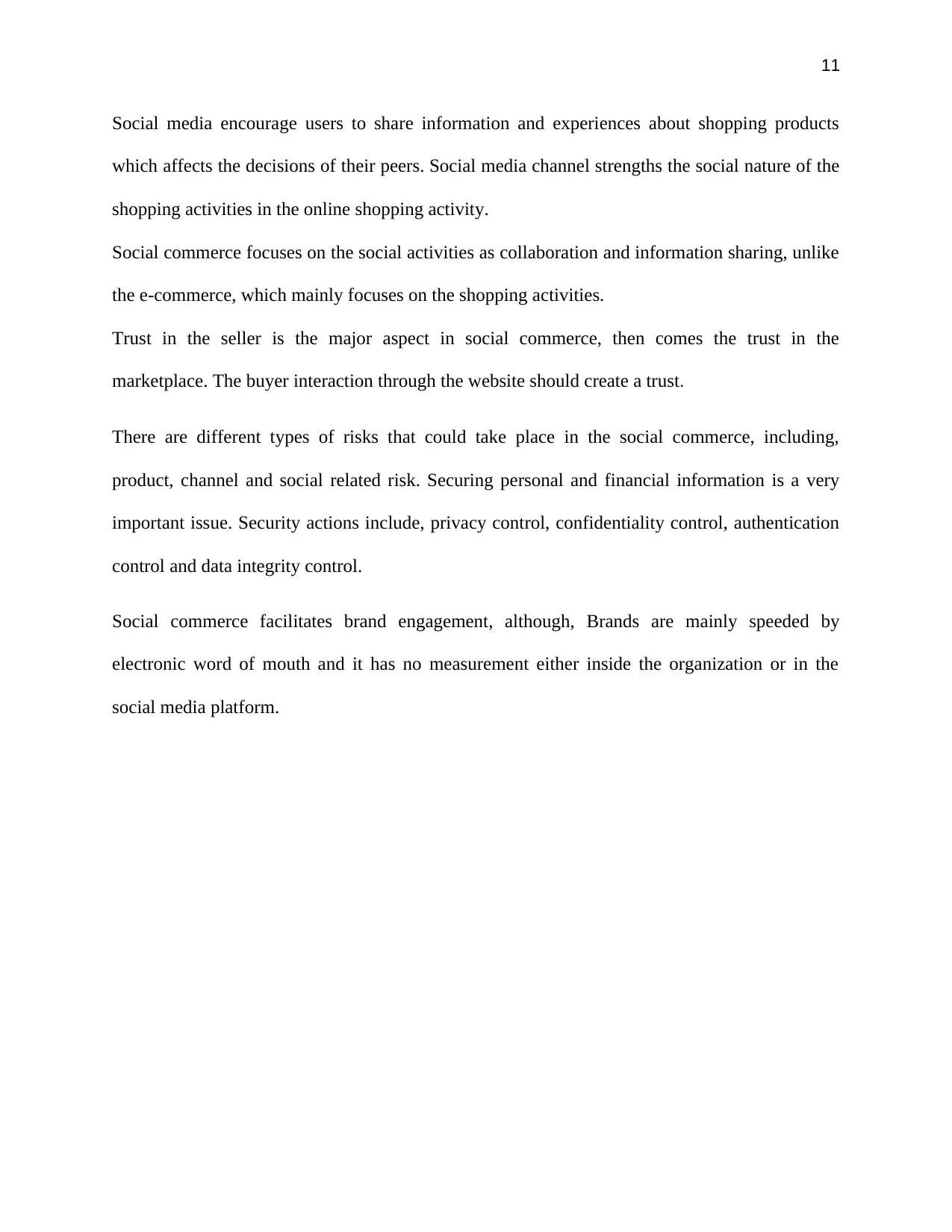
11
Social media encourage users to share information and experiences about shopping products
which affects the decisions of their peers. Social media channel strengths the social nature of the
shopping activities in the online shopping activity.
Social commerce focuses on the social activities as collaboration and information sharing, unlike
the e-commerce, which mainly focuses on the shopping activities.
Trust in the seller is the major aspect in social commerce, then comes the trust in the
marketplace. The buyer interaction through the website should create a trust.
There are different types of risks that could take place in the social commerce, including,
product, channel and social related risk. Securing personal and financial information is a very
important issue. Security actions include, privacy control, confidentiality control, authentication
control and data integrity control.
Social commerce facilitates brand engagement, although, Brands are mainly speeded by
electronic word of mouth and it has no measurement either inside the organization or in the
social media platform.
Social media encourage users to share information and experiences about shopping products
which affects the decisions of their peers. Social media channel strengths the social nature of the
shopping activities in the online shopping activity.
Social commerce focuses on the social activities as collaboration and information sharing, unlike
the e-commerce, which mainly focuses on the shopping activities.
Trust in the seller is the major aspect in social commerce, then comes the trust in the
marketplace. The buyer interaction through the website should create a trust.
There are different types of risks that could take place in the social commerce, including,
product, channel and social related risk. Securing personal and financial information is a very
important issue. Security actions include, privacy control, confidentiality control, authentication
control and data integrity control.
Social commerce facilitates brand engagement, although, Brands are mainly speeded by
electronic word of mouth and it has no measurement either inside the organization or in the
social media platform.
⊘ This is a preview!⊘
Do you want full access?
Subscribe today to unlock all pages.

Trusted by 1+ million students worldwide
1 out of 15
Related Documents
Your All-in-One AI-Powered Toolkit for Academic Success.
+13062052269
info@desklib.com
Available 24*7 on WhatsApp / Email
![[object Object]](/_next/static/media/star-bottom.7253800d.svg)
Unlock your academic potential
Copyright © 2020–2025 A2Z Services. All Rights Reserved. Developed and managed by ZUCOL.





